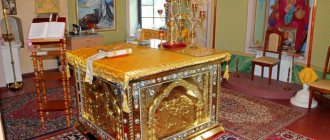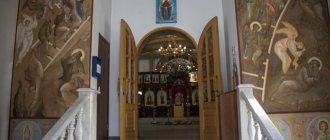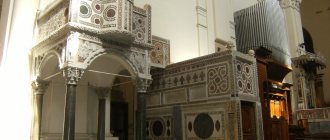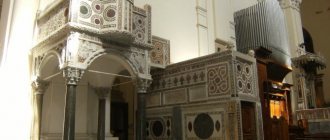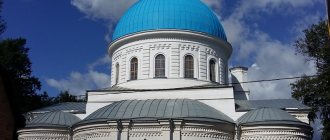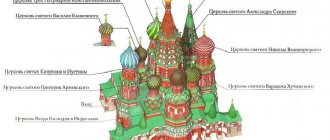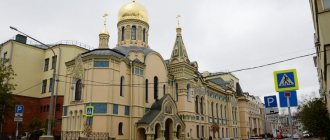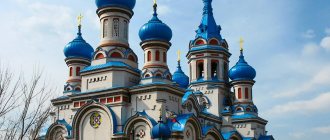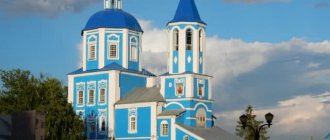Story
The very first temple is considered to be the upper room where the Last Supper . On it Christ established the Sacrament of the Eucharist. Then the first Christians chose clean, spacious premises for churches. Later, during the persecution of Christians, they had to pray in hidden places. They were located in dungeons and were called catacombs. These places of prayer have still been preserved, for example in Rome.
Then they began to build temples facing east. About thirty churches appeared in Rome between the persecutions. At first, the priests stood facing the people and prayed like this, seeing in everyone present the image of God Himself. But then, in order to avoid temptations, they began to turn their faces to the east. The first altars and iconostases appeared.
A special surge in the construction of churches occurred during the time of Saints Constantine and Helena . Among them is the Church of the Holy Sepulcher. Former pagan temples or administrative buildings (basilicas) were converted into Christian churches. They were rectangular in shape. Gradually, extensions for the altar and vestibules began to appear.
Russian Orthodox Church
(Latin altar (altare, altaria), probably from alta ara - elevated altar; Greek bema - elevation), a general term for the sacred place of sacrifice.
In the Holy Scriptures, the word altar (including in glorious translations) denotes a specially created elevation for bringing sacrifices to the Most High God (for example, 2 Chron. 26.16; Ps. 50.21; 83.4). In the pagan cults of classical antiquity, there were also sacrificial altars - natural or artificially created elevations of stones, earthen mounds, etc.; later complex architectural structures made of marble with many decorations appeared.
In Latin Christian texts (and, more broadly, in ancient and modern Western languages), the word altar usually refers to the table for offering the Eucharistic Sacrifice, that is, St. throne. However, in the Slavic (including Russian) tradition, the term altar was not assigned to St. himself. the throne, and behind that part of the temple where St. throne and which is also called the altar space.
In the Orthodox Church, the altar (altar space) is always located in the eastern (with extremely rare exceptions) half of the temple, closer to the apse, often on a raised platform, to which one or more steps lead from the naos. Already from the 3rd century. the altar space began to be enclosed with a low barrier, from which the altar barrier was subsequently formed, which in the late Byzantine and Russian traditions developed into an iconostasis.
In the space of the altar, except for St. the throne, which is located in the center and above which a canopy-ciborium can be arranged (in the Slavic tradition - a canopy), along the arc of the apse there is always a single or multi-stage bench or a row of seats (Greek synthronon, Slavic - co-throne), usually with a bishop's seat in the middle (Greek kathedra - department, high place). For St. As a rule, the throne contains the seven-branched candlestick, altarpiece Cross and images.
In the pre-altar part, along the side (deacon's) and central (holy, royal) gates there is a path-soleia (in early and middle Byzantine churches the solea was not located across the axis of the temple, in front of the altar, but connected the altar with the pulpit, which was located in the center of the temple).
Adjacent to the altar from the north is the room in which proskomedia is performed (in modern Russian usage this room is called an altar), and from the south there is a deaconnik (or sacristy), in which liturgical vestments and liturgical books are stored. Often in Orthodox churches (especially small ones or those built after the 16th century), the altar space is combined with the spaces of the altar and deacon; in this case, the table for performing proskomedia (Greek prothesis, Russian altar) is located in the altar, near the northern wall. The altar also contains fixtures necessary for liturgical practice (wall cabinets, “stoves,” washbasins, etc.).
In the Byzantine and Western European traditions, under the altar there could be a crypt (a small room; in the 4th–6th centuries, the practice of placing holy relics in the crypt was established; subsequently, holy relics began to be placed simply in the holy altar); in Rus' sometimes a basement was set up. The walls of the altar and the vaulted ends of the apses (conchs) are usually decorated with mosaics or frescoes.
According to the canons of the Orthodox Church, only clergy and clergymen are allowed to enter the space of the altar, but in practice an exception is made for men helping in the altar (sacristans and altar boys; in women’s monasteries they are replaced, according to the canons, by elderly nuns (15th canon of Nicephorus the Confessor)). Only bishops, presbyters and deacons, as well as Orthodox kings have the right to receive communion at the altar (canonical canons of the Councils: Laodicean 14 and 19; VI Ecumenical 69; VII Ecumenical 14).
In symbolic interpretations of the Orthodox church, the altar space is likened to heaven, paradise, the Holy of Holies of the Old Testament temple; special veneration of the altar is due to the fact that this is the place where the Eucharistic Sacrifice was offered.
What does the temple consist of?
Modern temples are usually built in several forms:
- in the form of a cross;
- in the form of a ship (symbolizing the boat of salvation or Noah's ark);
- circle shape (symbolizes eternity);
- like an eight-pointed star (symbol of a guiding star).
There is always a dome at the top - a symbol of Heaven . It is crowned with a cross. Some churches have not one, but several domes:
- The 2 domes signify the Divine and human nature of Christ.
- 3 domes - in honor of the Holy Trinity.
- 5 domes - in honor of the Lord and the four evangelists.
- 7 domes - in honor of the Sacraments and Ecumenical Councils.
- 9 domes - according to the number of angelic ranks.
- 13 domes - in honor of the twelve apostles and Christ.
There is usually a bell tower above the entrance.
External structure of an Orthodox church:
The temple consists of three parts:
- The narthex Here stand those preparing for the Sacrament of Baptism, as well as repentant sinners.
- Middle part. Here faithful Christians stand and pray.
- Altar. It personifies Heaven; here the clergy pray before the Throne.
Internal structure of the temple
Entering any church, you can see the division into three main zones:
- porch;
- main or middle part;
- altar.
The narthex is the very first part of the building behind the entrance doors. In ancient times, it was accepted that it was in the narthex that sinners before repentance and catechumens stood and prayed - people who were just preparing to accept Baptism and become full members of the Church. In modern churches there are no such rules, and candle kiosks are most often located in the vestibules, where you can buy candles, church literature and submit notes for commemoration.
The narthex is a small space between the door and the temple
In the middle part are all those praying during the service. This part of the church is also sometimes called the nave (ship), which again refers us to the image of Noah’s ark of salvation. The main elements of the middle part are the solea, pulpit, iconostasis and choir. Let's take a closer look at what it is.
Solea
This is a small step located in front of the iconostasis. Its purpose is to elevate the priest and all participants in the service so that they can be better seen and heard. In ancient times, when churches were small and dark, and even crowded with people, it was almost impossible to see and hear the priest behind the crowd. That's why they came up with such an elevation.
Pulpit
In modern churches this is part of the solea, most often oval-shaped, which is located in the middle of the iconostasis directly in front of the Royal Doors. On this oval ledge, sermons are delivered by the priest, petitions are read out by the deacon, and the Gospel is read. In the middle and on the side of the pulpit there are steps to ascend to the iconostasis.
The Gospel is read from the pulpit and sermons are preached
Choir
The place where the choir and readers are located. Large churches most often have several choirs - upper and lower. The lower choirs are usually located at the end of the solea. On major holidays, several choirs, located in different choirs, can sing in one church at once. During regular services, one choir sings from one choir.
Iconostasis
The most noticeable part of the interior decoration of the temple. This is a kind of wall with icons that separates the altar from the main part. Initially, iconostases were low, or their function was performed by curtains or small grilles. Over time, icons began to be hung on them, and the height of the barriers grew. In modern churches, iconostasis can reach the ceiling, and the icons on it are arranged in a special order.
The main and largest gate leading to the altar is called the Royal Doors. They depict the Annunciation of the Blessed Virgin Mary and icons of all four evangelists. On the right side of the Royal Doors they hang an icon of Christ, and behind it an image of the main holiday in honor of which the temple or this border is consecrated. On the left side there is an icon of the Mother of God and one of the especially revered saints. On the additional doors to the altar it is customary to depict Archangels.
The Last Supper is depicted above the Royal Doors, along with the icons of the great twelve feasts. Depending on the height of the iconostasis, there may also be rows of icons depicting the Mother of God, saints, and passages from the Gospel.
Iconostasis of the Annunciation Cathedral
The iconostasis is crowned with a crucifix, and next to it are images of the Mother of God and St. John the Theologian. It was they who stood on Golgotha during the execution of the Lord on the cross. The same arrangement can be seen on the large crucifix, which is located on the side of the iconostasis.
The main idea of designing the iconostasis is to present the Church in its entirety, with the Lord at the head, with the saints and Heavenly powers. A person who prays at the iconostasis, as it were, stands before everything that constitutes the essence of Christianity from the time of the Lord’s earthly life to this day.
About prayer in the temple:
- Why is it not enough to believe in your soul and not go to church?
- Is it possible to go to temple during pregnancy?
- How to behave correctly in church for children
What is an altar in a church
The interior space of the Christian church is divided into three parts:
- The narthex
- The middle.
- Altar room.
The altar is the main part of the temple, a symbol of the Throne of the Lord
To enter any Orthodox church you need to climb the steps to the porch (platform). In the vestibule, the betrothal ceremony and lithium ceremony are performed, a prayer service for the mothers in labor is read, and the rite of announcement is read. This western part of the church is also called the refectory.
In the middle space of God's house during church services, parishioners stand and participate in the services. It is separated from the altar part by an iconostasis, which serves as a prototype of the usefulness of the Heavenly monastery.
The altar is a prototype of the Heavenly monastery; it symbolically repeats the famous upper room where the Last Supper took place. Particular purity and holiness are always observed here; only clergy are allowed to enter here, showing the laity an example of humble righteousness.
On a note! In Catholicism, the altar refers to the Throne itself, where the Sacrament of Communion is celebrated, as well as the picture placed above the meal.
Narthex
The vestibule, which is part of the design of a Christian church, is its vestibule. At the origins of faith, those who repented or those who were preparing for Holy Baptism stopped there. In the narthex there is most often a church box for selling prosphoras, candles, icons, crosses, and for registering weddings and baptisms. Those who have received penance from the confessor, and all people who, for some reason, consider themselves currently unworthy to enter the temple can stand in the vestibule.
Visit to a Buddhist temple
Those who want to visit a Buddhist temple must adhere to certain requirements. Legs and shoulders must be covered with opaque clothing. Like other religions, Buddhism believes that lack of proper dress is disrespect for faith.
Buddhists consider the feet to be the dirtiest part of the body because they come into contact with the ground. Therefore, when entering the temple, you must take off your shoes. It is believed that this will make your feet cleaner.
It is imperative to know the rule by which believers sit. The feet should under no circumstances point towards the Buddha or any saint, so Buddhists prefer to remain neutral - sitting in the lotus position. You can simply bend your legs under yourself.
Altar
When considering the structure of the temple, special attention should be paid to the altar. This is the most important part of the church, intended only for the clergy, as well as for those persons who serve them during services. The altar contains images of Paradise, the heavenly dwelling of the Lord. Denotes a mysterious side in the Universe, part of the sky. Otherwise, the altar is called “sky on Zele”. Everyone knows that after the Fall, the Lord closed the Gates to the Kingdom of Heaven for ordinary laymen; entry here is possible only for God’s anointed. Having a special sacred meaning, the altar always inspires reverence in believers. If a believer, helping in the service, putting things in order or lighting candles, comes here, he must bow to the ground. Laymen are prohibited from entering the altar for the simple reason that this place must always be clean, holy, this is where the Holy Meal is located. Crowds and disorder, which mere mortals can tolerate due to their sinful nature, are not allowed in this place. This is the place where the priest concentrates his prayers.
A brief dictionary of architectural terms
An apse is an altar projection in a temple, semicircular or polygonal in plan, where the altar is located.
An arcature belt is a wall decoration in the form of a series of decorative arches.
The drum is the cylindrical or multifaceted upper part of the temple on which the dome is built.
Baroque is an architectural style of the 17th-18th centuries, characterized by decorative splendor, complex forms, and picturesqueness.
A barrel is a form of covering in the form of two rounded slopes converging at the top under the ridge.
Octagon is an octagonal structure.
The head is a dome with a drum crowning the temple building.
Zakomara - vault, semicircular completion of the upper outer walls of the church, usually corresponding to the shape of the vaults
Iconostasis is an altar barrier in a church that separates the altar from the main part of the church, and has several tiers with icons.
Interior - the interior space of a building.
Cornice is a horizontal protrusion on a wall that supports the roof of a building.
Classicism is an architectural style of the 18th - early 19th centuries; marked by the appeal and imitation of the ancient heritage. Classicism is characterized by clarity and geometricism of forms, logical layout, and restraint in decoration.
Kokoshnik is a decorative element of coverings, reminiscent of a traditional women's headdress.
A column is an architecturally processed usually round pillar.
Composition is the construction (structure) of a building, the relationship of its individual parts that make up a single whole. Horse
- the junction of two roof slopes.
A buttress is a vertical projection of a wall that increases the stability of a building.
The cube is the main volume of the temple.
Ploughshare - wooden tiles used to cover domes, barrels and other tops of the temple.
A shoulder is a flat, vertical ledge in a wall.
Onion - a church dome that resembles an onion in shape.
Platband - frame of a window opening.
Nave - (literally “ship”) the longitudinal part of the temple, separated from the neighboring one by an arcade or blade on the surface of the wall.
The porch is an open or closed porch in front of the entrance to the temple.
A pilaster is a structural or decorative flat vertical projection on the surface of a wall.
Basement - the bottom floor of a building.
A curb is a decorative strip of bricks placed on edge at an angle to the surface of the facade. Has the shape of a saw.
A portal is an architecturally designed entrance to a building.
Portico - a gallery on columns or pillars, usually in front of the entrance to a building.
The throne is a high table standing in the middle of the church altar.
A chapel is a small temple attached to the main church building, which has its own altar in the altar and is dedicated to a saint or holiday.
The narthex is a room in the form of a hallway in front of the church portal.
Reconstruction - reconstruction, modernization, renovation of a building.
Restoration is the restoration of a building to its original (or close to its original) form.
The rotunda is a round building covered with a dome.
Rustication is a decorative treatment of the plaster surface of a wall, imitating masonry made of large stones.
A vault is a spatial structure, the overlap of structures, having the shape of a convex curved surface. There are cross, closed (box) and other vaults.
The refectory is part of the church, a low extension on the western side of the church, which served as a place for preaching and public meetings.
Facade is one of the sides of a building.
Chetverik is a structure with a tetrahedral plan.
A tent is a high four-, six-, or octagonal pyramidal covering of a tower, church, or bell tower.
A fly is a rectangular depression in the wall.
The apple is a ball at the end of the dome under the cross.
Tier is a horizontal division of the volume of a building decreasing in height.
Construction of a Buddhist temple
Many believers are interested in how Buddha temples are arranged. Let's give some brief information. In Buddhist temples, everything is also set according to strict rules. All Buddhists revere the “Three Treasures” and it is in the temple that they seek refuge - with the Buddha, his teachings and the community. The right place is where all the “Three Treasures” are collected; they must be reliably protected from any influence, from outsiders. The temple is a closed area, protected from all sides. Powerful gates are the main requirement in the construction of a temple. Buddhists do not distinguish between a monastery and a temple - for them it is the same concept.
Every Buddhist temple has an image of Buddha, whether embroidered, painted or sculpture. This image should be placed in the “golden hall”, facing east. The main figure is enormous; all the others depict scenes from the life of the saint. The temple also has other images - these are all creatures revered by Buddhists. The altar in the temple is decorated with figures of famous monks; they are located just below the Buddha.
